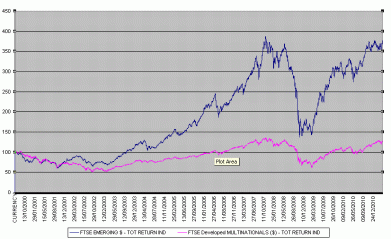So who is right?
The answer, it seems, lies in whether you take a long-term view or a short-term view.
In a recent strategy report, Goldman Sachs threw its weight behind the DM multinational story.
GS recommended investors take long positions in several indices: one, an index of European companies with high exposure to EM and another, the Bric Nifty 50 index, composed of global DM corporations with exposure to Brazil, Russia, India and China.
“We would not be surprised to see companies with high exposure to these areas to trade at a premium compared to companies exposed to a lackluster domestic market,” the authors of a Strategy Matters report wrote.
But not all investors are convinced that investing in EM-exposed DM equities offers any meaningful exposure to emerging markets.
Allan Conway, head of global emerging market equities at Shroders told beyondbrics: “If you believe in the EM story and you want EM exposure then what you must do is invest in EM.” Referring to the strategy of gaining EM exposure through DM stocks Conway said: “When you invest in that basket you’re buying exposure to developed markets.”
Robert Holderith, president and founder of Emerging Global Advisors, agrees with this view and told beyondbrics his EM fund assets are invested directly in those countries.
“We believe that the sentiment for emerging markets in the long term story is better than ever,” Holderith said, explaining EGA’s view that by investing in developed market multinationals with EM exposure, “you get earnings dilution, currency dilution and executive pay dilution.”
He said: “EM has become more attractive on its own merits.”
So which view is an investor to believe?
beyondbrics has plotted a chart to test the theory, using the FTSE emerging market index and the FTSE developed multinationals index, which includes multinationals that derive 30 per cent or more of their revenues from outside their home economic region, to see whether returns are correlated and which index yields higher returns
What we’ve found is that if you plot a chart to begin in January 2009 there is indeed strong correlation between the FTSE EM and FTSE developed multinational index.
(see Chart 1 below)

(see Chart 1 below)

But if we rebase the chart to begin at the start of 2000, we get a very different picture and investing in emerging markets looks to have been the smarter choice. (see Chart 2 below)
And what about the future? Investors are better off going to a fortune teller for that kind of information.


No comments:
Post a Comment